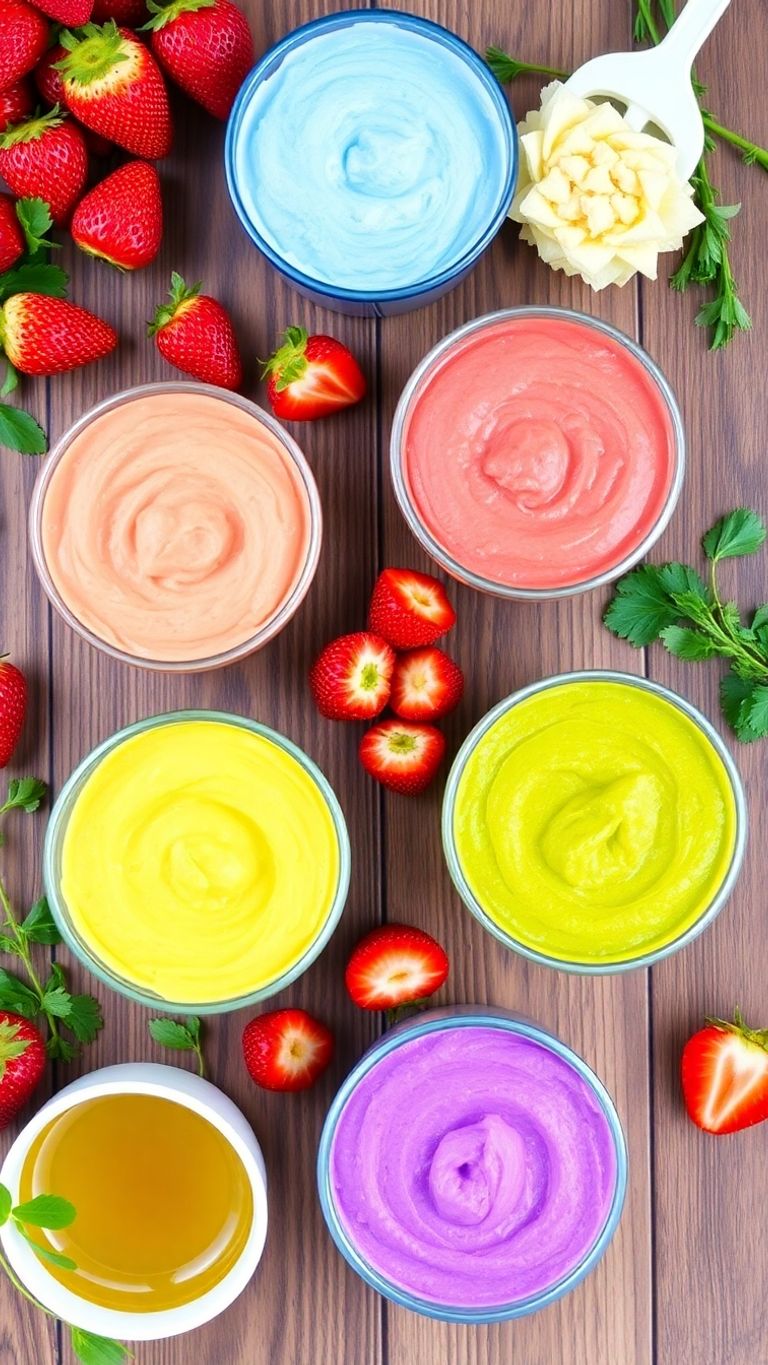Spring is here, and it’s the perfect time to refresh your skincare routine. If your skin is looking a bit lackluster after the long winter, don’t worry! You can whip up some easy DIY face masks right at home using ingredients you probably already have in your kitchen. These natural face masks will help bring back that spring glow and make your skin feel fresh and rejuvenated. Here are five simple recipes to get you started on your journey to glowing skin this season.
Key Takeaways
- DIY face masks are easy to make with kitchen ingredients.
- Natural face masks can help revive dull skin.
- Spring is a great time to refresh your skincare routine.
- Homemade skin remedies are budget-friendly and effective.
- Try these masks for a glowing complexion this spring.
1. Hydrating Avocado Mask

Avocados aren’t just for toast; they’re also amazing for your skin! They’re packed with healthy fats and vitamins that can seriously boost your skin’s hydration. If you’re dealing with dry, dull skin, this mask might just be your new best friend. It’s super easy to make, and you probably already have most of the ingredients in your kitchen. Let’s get into how you can whip up this simple yet effective mask.
Why Avocado?
Avocados are rich in omega-3 fatty acids and B vitamins, which help to restore your skin’s lipid layer. This means your skin will be better at retaining moisture, leading to a brighter, plumper complexion. Plus, they’re gentle enough for even sensitive skin. You can improve skin tone and texture with this simple mask.
Simple Recipe for Dry Skin
For a basic hydrating avocado mask, you’ll need:
- 1/2 ripe avocado
- 2 tablespoons of cold milk
- 1 teaspoon of honey (optional, for extra hydration and antibacterial benefits)
Mash the avocado until it’s smooth and creamy. Then, mix in the milk and honey (if using). Apply the mask to your clean, dry face, avoiding the eye area. Leave it on for 15-20 minutes, and then rinse off with lukewarm water. Pat your skin dry and follow with your favorite moisturizer. You can also substitute the honey for blended cucumber packed full of vitamin E to create a soothing face mask to hydrate and reduce swelling & puffiness.
Adding Extra Goodness
Want to take your avocado mask to the next level? Here are a few ideas:
- Olive Oil: Add a teaspoon of olive oil for extra moisture and anti-inflammatory benefits. It’s great for calming irritated skin.
- Yogurt: Mix in a tablespoon of plain yogurt for a boost of probiotics, which can help balance your skin’s microbiome.
- Oatmeal: Add a tablespoon of finely ground oatmeal for gentle exfoliation and soothing properties. This is especially good if you have irritated skin.
I tried the avocado mask with olive oil last week, and my skin felt incredibly soft and hydrated afterward. It’s definitely going into my regular skincare routine!
Tips for Best Results
To get the most out of your avocado mask, here are a few tips:
- Use a ripe avocado. It should be soft and easy to mash. If it’s too hard, it won’t blend well, and you won’t get the full benefits.
- Apply the mask to clean skin. This will help the ingredients penetrate better.
- Don’t leave the mask on for too long. 15-20 minutes is usually enough. Leaving it on longer can actually dry out your skin.
- Follow up with a moisturizer. This will help lock in the hydration from the mask.
Frequency of Use
How often should you use this mask? For dry skin, you can use it 1-2 times a week. If you have oily or combination skin, once a week should be enough. Pay attention to how your skin feels and adjust accordingly. Remember, everyone’s skin is different, so what works for one person might not work for another. This avocado mask is great for dry, normal, and combination skin.
Final Thoughts
Making your own face masks can be a fun and rewarding way to care for your skin. This hydrating avocado mask is a simple, effective way to combat dullness and dryness, leaving you with a healthy, glowing complexion. So, go ahead and give it a try – your skin will thank you!
2. Brightening Papaya Honey Mask
Dealing with dull skin can be frustrating, but don’t worry, a solution is here! This papaya honey mask is a fantastic way to bring back that radiant glow. Papaya contains enzymes that gently exfoliate, while honey soothes and hydrates. Together, they create a powerful combination that can transform your complexion. Let’s explore how you can easily whip up this mask at home and say hello to brighter, more vibrant skin.
The Power of Papaya and Honey
Papaya is a natural exfoliant, thanks to an enzyme called papain. This enzyme helps to remove dead skin cells, revealing the brighter skin underneath. Honey, on the other hand, is a humectant, meaning it draws moisture into the skin. It also has antibacterial properties, which can help to keep your skin clear and healthy. This mask is especially great if you’re looking to achieve a radiant bridal glow before your big day.
Simple Steps for a Glowing Complexion
Making this mask is incredibly easy. You likely have most of the ingredients already in your kitchen. Here’s what you’ll need:
- 1/2 cup of ripe papaya, mashed
- 1 tablespoon of raw honey
- Optional: A squeeze of lemon juice for extra brightening
First, mash the papaya until it’s smooth. Next, mix in the honey until well combined. If you’re using lemon juice, add a few drops. Apply the mask to your clean, dry face, avoiding the eye area. Leave it on for 15-20 minutes, then rinse with lukewarm water. Pat your skin dry and follow with your favorite moisturizer. You’ll notice an immediate difference in your skin’s brightness and texture. For an extra boost, consider incorporating other Ayurvedic masks into your routine.
Why This Mask Works
This mask isn’t just about the ingredients; it’s about how they work together. The papain in papaya gently removes dead skin cells, while honey’s antioxidant properties help to even out skin tone. The result is a brighter, more radiant complexion that feels soft and hydrated. Plus, it’s a completely natural way to give your skin a boost, without harsh chemicals or expensive treatments.
Tips for Best Results
To get the most out of your papaya honey mask, here are a few tips:
- Use ripe papaya: A ripe papaya is easier to mash and contains more enzymes.
- Choose raw honey: Raw honey retains more of its beneficial properties compared to processed honey.
- Patch test: Before applying the mask to your entire face, test it on a small area to ensure you don’t have any adverse reactions.
- Consistency is key: Use this mask once or twice a week for best results.
With consistent use, this mask can help to fade dark spots, even out skin tone, and leave you with a healthy, radiant glow. So, go ahead and give it a try – your skin will thank you!
3. Detoxifying Green Clay Mask

Feeling like your skin needs a serious reset? A detoxifying green clay mask might be just what you need. Green clay, also known as French green clay, is a powerhouse when it comes to drawing out impurities and excess oil from your pores. It’s like a magnet for all the gunk that builds up on your skin, leaving you with a clearer, brighter complexion. Plus, it’s surprisingly easy to make a mask at home. Let’s explore how you can whip up your own detoxifying treatment.
Why Green Clay?
Green clay is rich in minerals like magnesium, calcium, and potassium, which are beneficial for skin health. These minerals not only help to detoxify but also work to rebalance and revitalize your skin. If you’re dealing with oily or acne-prone skin, this mask can be a game-changer. It helps to absorb excess sebum, reducing shine and preventing breakouts. For those with sensitive skin, it’s always a good idea to do a patch test first to ensure you don’t have any adverse reactions. You can find green clay at most health food stores or online.
Simple DIY Recipe
Making your own green clay mask is super simple. You only need a few ingredients, and you probably already have some of them in your kitchen. Here’s a basic recipe to get you started:
- 1 tablespoon of green clay
- 1 teaspoon of water (or apple cider vinegar for extra detoxifying power)
- ½ teaspoon of honey (optional, for added moisture)
Mix the ingredients in a non-metal bowl until you form a smooth paste. Avoid using metal utensils or bowls, as they can react with the clay and reduce its effectiveness. Apply the mask to your face, avoiding the eye area. Let it sit for about 10-15 minutes, or until it starts to dry. Rinse off with warm water and pat your skin dry. Follow up with your favorite moisturizer to keep your skin hydrated. This homemade clay face mask can be a weekly ritual.
Boosting the Benefits
Want to take your green clay mask to the next level? There are plenty of ways to customize it to suit your specific skin needs. For example, if you have acne-prone skin, you can add a drop or two of tea tree oil for its antibacterial properties. If you’re looking for extra exfoliation, try adding a pinch of finely ground oats. For a more soothing effect, you can substitute the water with chamomile tea. The possibilities are endless! Just remember to introduce new ingredients gradually and always listen to your skin. You can even combine it with dead sea mud and bentonite clay to detoxify the skin.
Tips for Best Results
To get the most out of your green clay mask, here are a few tips to keep in mind. First, always start with a clean face. This will help the mask penetrate deeper and work more effectively. Second, don’t let the mask dry completely. Over-drying can strip your skin of its natural oils and leave it feeling tight and uncomfortable. Third, be gentle when removing the mask. Use a soft, damp cloth and avoid scrubbing. Finally, always follow up with a moisturizer to replenish any lost hydration. With these tips, you’ll be well on your way to achieving a clearer, healthier complexion. You can also try a bentonite clay face mask for similar results.
Remember, consistency is key. Incorporating a green clay mask into your skincare routine once or twice a week can make a noticeable difference in the overall health and appearance of your skin. So, go ahead and give it a try – your skin will thank you for it!
4. Exfoliating Brown Sugar Mask

Dealing with dull skin can be frustrating, but don’t worry, you’ve got options! Brown sugar isn’t just for baking; it’s also a fantastic natural exfoliant. It’s gentler than regular sugar, making it a great choice for most skin types. This mask will help you buff away those dead skin cells, revealing a smoother, brighter complexion. Plus, it’s super easy to whip up with ingredients you probably already have in your pantry. Let’s get started and say goodbye to dullness!
Why Brown Sugar?
Brown sugar is a natural humectant, which means it helps your skin retain moisture. This is a big plus because exfoliation can sometimes leave your skin feeling dry. Also, the granules are smaller and softer than those of white sugar, making it a less abrasive natural exfoliator. This is especially important if you have sensitive skin. You want to gently buff away dead skin cells, not irritate your face!
Simple Brown Sugar Scrub Recipe
This recipe is so easy, you’ll wonder why you haven’t tried it before. All you need are two ingredients:
- 2 tablespoons of brown sugar
- 1 tablespoon of olive oil (or coconut oil, or honey)
Mix the ingredients together in a small bowl until you form a paste. Gently massage the scrub onto your clean, damp face in circular motions for about a minute. Avoid the eye area. Rinse thoroughly with warm water and pat your skin dry. Follow up with your favorite moisturizer. You’ll immediately notice how much smoother your skin feels. For mature skin, you can also try other homemade face scrubs to keep your skin looking youthful.
Brown Sugar and Honey Mask
Want to add a little extra oomph to your mask? Honey is your friend! Honey is a natural antibacterial and humectant, so it’s great for soothing and hydrating your skin. It also helps to improve blood circulation, which can give you a healthy glow.
- 2 tablespoons of brown sugar
- 1 tablespoon of raw honey
- 1 teaspoon of lemon juice (optional, for extra brightening)
Combine all ingredients in a bowl. Apply to your face, avoiding the eye area. Let it sit for 10-15 minutes, then rinse with warm water. Your skin will feel incredibly soft and refreshed. Remember, consistency is key. For best results, use this mask once or twice a week. You can also use a sugar scrub exfoliator to enhance your beauty routine.
Tips and Precautions
While brown sugar is generally gentle, it’s always a good idea to do a patch test before applying any new mask to your entire face. Apply a small amount to a discreet area, like your inner arm, and wait 24 hours to see if you have any adverse reactions. Also, don’t over-exfoliate! Overdoing it can strip your skin of its natural oils and cause irritation. Once or twice a week is plenty. If you have very sensitive skin, you might want to start with once a week and see how your skin responds. Remember, the goal is to gently enhance skin texture, not to scrub your face raw. If you experience any redness, burning, or itching, discontinue use immediately.
Exfoliating with brown sugar is a simple and effective way to brighten your complexion and improve your skin’s texture. It’s a budget-friendly option that you can easily incorporate into your skincare routine. So, go ahead and give it a try – your skin will thank you!
5. Soothing Yogurt Mask

Dealing with irritated skin? A yogurt mask might just be your new best friend. It’s incredibly easy to whip up, and you probably already have the main ingredient in your fridge. Yogurt contains probiotics, which can help calm inflammation and redness. Plus, it’s super moisturizing, leaving your skin feeling soft and supple. Let’s explore how you can create this simple yet effective mask.
Why Yogurt Works
Yogurt isn’t just a tasty snack; it’s also a skincare powerhouse. The lactic acid in yogurt acts as a gentle exfoliant, helping to remove dead skin cells and reveal brighter skin underneath. Furthermore, the probiotics in yogurt can help balance your skin’s microbiome, reducing inflammation and irritation. It’s a win-win!
Using a yogurt mask is a simple way to soothe and hydrate your skin. The natural probiotics and lactic acid work together to calm irritation and gently exfoliate, leaving your skin feeling refreshed and revitalized.
Simple Yogurt Mask Recipe
This recipe is so easy, you’ll wonder why you haven’t tried it sooner. All you need is plain, unflavored yogurt. For an extra boost, you can add a few other ingredients depending on your skin’s needs. Here’s a basic recipe to get you started:
- 1/4 cup plain yogurt
- 1 teaspoon honey (optional, for extra moisture)
- 1/2 teaspoon aloe vera gel (optional, for soothing)
Mix all the ingredients together in a small bowl. Apply a thin layer to your face, avoiding the eye area. Leave it on for 10-15 minutes, then rinse off with lukewarm water. Pat your skin dry and follow with your favorite moisturizer. You can also try a turmeric and yogurt mask for added benefits.
Customizing Your Mask
One of the best things about DIY masks is that you can customize them to suit your specific skin concerns. If you have dry skin, add a little olive oil or avocado for extra hydration. For oily skin, a squeeze of lemon juice can help control excess oil. And if you’re dealing with acne, a pinch of turmeric powder can provide anti-inflammatory benefits. Feel free to experiment and find what works best for you. You can even explore other DIY face mask recipes for more ideas.
Tips for Best Results
To get the most out of your yogurt mask, here are a few tips to keep in mind. First, always use plain, unflavored yogurt. Flavored yogurts often contain added sugars and artificial ingredients that can irritate your skin. Second, do a patch test before applying the mask to your entire face, especially if you have sensitive skin. Apply a small amount to your inner arm and wait 24 hours to see if any irritation occurs. Finally, don’t leave the mask on for too long. Overdoing it can dry out your skin. Remember, consistency is key. Incorporate this mask into your skincare routine once or twice a week for best results. You might also consider a vegan skincare approach for a more holistic routine.
When to Use a Yogurt Mask
Yogurt masks are great for a variety of skin concerns. They’re particularly helpful for soothing sunburned skin, reducing redness from irritation, and hydrating dry patches. If you’ve had a long day in the sun or your skin is feeling stressed, a yogurt mask can provide instant relief. It’s also a gentle way to exfoliate and brighten your complexion, making it a great addition to your weekly skincare routine. For those with oily skin, targeting the T-zone can be particularly effective.
Final Thoughts
So, there you have it! A simple, effective, and affordable way to soothe and revitalize your skin. Give this yogurt mask a try and see the difference it can make. Your skin will thank you for it! Plus, it aligns perfectly with the trend of plastic-free skincare, making it a sustainable choice for your beauty routine.
Embrace Your Glow This Spring
As we welcome spring, it’s the perfect time to refresh not just our wardrobes but our skincare routines too. These DIY face masks are simple to whip up and can really bring your skin back to life without breaking the bank. Remember, the best part is that you can customize these recipes to suit your skin’s needs. So, grab those ingredients from your kitchen, take a little time for yourself, and enjoy the process. Your skin will thank you, and you might just find a new favorite ritual. Here’s to glowing skin and a vibrant spring!
Frequently Asked Questions
What are some benefits of using DIY face masks?
DIY face masks can hydrate, brighten, and soothe your skin using natural ingredients. They are often less expensive than store-bought options and can be customized to fit your skin’s needs.
How often should I use a face mask?
You can use a face mask once or twice a week, depending on your skin type and the ingredients in the mask. If you have sensitive skin, start with once a week.
Can I store leftover face mask mixture?
It’s best to use the face mask right after making it. If you have leftovers, store them in the fridge and use them within a day or two. Always check for any changes in smell or color before using.
Are these face masks suitable for all skin types?
Most of these DIY masks are gentle and can be used on various skin types. However, if you have sensitive skin, do a patch test first to make sure you don’t have a reaction.
What should I do if I experience irritation from a face mask?
If you feel any irritation or discomfort while using a mask, wash it off immediately with warm water. If irritation persists, consult a dermatologist.
Can I use these masks on my body as well?
Yes, you can use these masks on other parts of your body, like your neck or hands, but make sure to test a small area first to avoid irritation.







